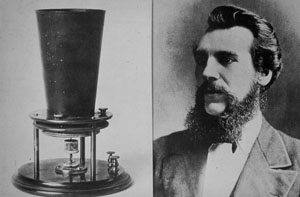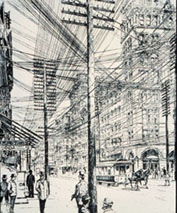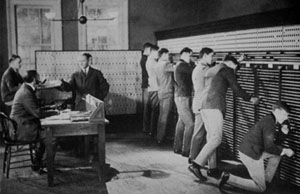Alexander Graham Bell invented the telephone over 100 years ago. At first, the telephone lines were separate lines that connected pairs of telephones. In other words, each person that had a telephone could talk to one other telephone. The first telephone line was set up in Boston in 1877. It connected the home of Charles Williams Jr. in Somerville MA with his Boston office. The use of private lines was, of course, very restrictive. People wanted to be able to talk with more than one other household. A central interconnection facility was needed, a place where telephone lines would be connected as desired. 1 Telephone lines were needed to connect private telephones with the central interconnection facility.
 Alexander Graham Bell and Telephone
Alexander Graham Bell and TelephoneThe first telephone lines were overhead lines, placed on telephone poles or attached to racks on rooftops. The telephone lines were single grounded wires made of iron or steel. Some wires were galvanized for corrosion resistance, but corrosion problems were never the less prevalent. The lines were single grounded wires and they were inherently noisy. Phosphor bronze wires and compound copper steel wires were made in attempts to decrease the noise in the lines. The benefits of using copper conducting wire were known, but the technology was not available to make a copper wire strong enough for an overhead wire. Then in 1877 Thomas Doolittle developed the process for hard drawn copper wire in the Naugatuck Valley of Connecticut. He had soft, annealed copper wire drawn through a series of dies in order to increase its tensile strength. The hard drawn copper wire was strong enough for overhead wires and copper took over the telephone wire market. In 1884 an experimental long distance telephone line made of copper was set up between Boston and New York. In 1885 a hard drawn copper telephone line was set up between New York and Philadelphia. Many manufacturers started producing hard drawn copper wire in order to meet the increased demand for telephone wires. The use of hard drawn copper wire then expanded into electrical transmission lines and throughout the electrical industry.
The metallic circuit or two-wire circuit was developed and patented by Alexander Graham Bell in 1881. The metallic circuit was an important development in telephony because it eliminated a lot of the electrical disturbances and unwanted noise in the lines. The installation of metallic circuits was both physically and financially difficult. The entire overhead wiring system had to be replaced with two wires instead of one for the metallic circuit lines. There was a gradual conversion from grounded to metallic circuit lines between 1890 and 1900. Advances were also made in design of insulators and wire transpositions.
Interest grew in the development of telephone cables. Many telephone wires were contained in one telephone cable. Better insulation, both electromagnestic and water resistance, were required. Early telephone cables relied upon the technology used in the manufacture of telegraph cables. Gutta percha and various rubber compounds were used for insulating and water proofing the telegraph and early telephone cables. Telephone cables were employed for aerial, underwater and underground use around 1879. Early cables were single grounded wires followed by metallic circuits lines after their development. By 1887 all of the newly manufactured cables were metallic circuit cables. Some of the early telephone cable applications were across the East River Bridge, under the North River between New York and New Jersey and across the Delaware River from Philadelphia to Camden. There were numerous cable manufacturers. The cables made by the different manufacturers were very similar but not identical. The cables contained up to 100 copper wires. They were insulated with cotton, cotton impregnated with paraffin, gutta percha or a rubber compound, and then in wrapped in lead.
 Manhattan Street, circa 1890
Manhattan Street, circa 1890There was a large demand for telephone cables. Telephone cables were needed to replace the large number of aerial wires present in the cities. In the 1880's the major telephone cable concerns were noise elimination, waterproofing and fitting more wires in each cable. The technique of wrapping the conducting wires in lead was developed to eliminate electromagnetic noise in the lines. Other insulating techniques, such as covering the insulated wires with tin foil and using additional insulating layers, were employed. Techniques for impregnating the lead tubes after the conducting wires were drawn through with melted paraffin, resin, a mixture of paraffin and resin or high test illuminating oil were used to protect the insulation from moisture. 2 By the late 1890's telephone and electric power cables were laid underground in conduits made of creosoted wood . Then vitrified clay conduits were developed. The multiple duct vitrified clay conduit became the main type of underground construction used. A separate square hole was provided for each cable, and when more ducts were required sections of conduit could be added.
The general complaints of the poor voice transmission over the telephone cables, unrecognizable voices, and muffled and hollow sounds were still present. There were two major improvements made to telephone cable in the late 1880's. The first was the issuance of a specification for a standard type of telephone cable in 1888. The specification outlined a metallic circuit or twisted pair cable. The wires were 18 B & S gauge copper conducting wire (40 mils in diameter) covered with at least two layers of cotton and sheathed in a 97% lead, 3% tin alloy pipe. The spaces in the core and between the core and the pipe were filled with an insulating material. A two inch diameter cable could contain up to 52 pairs of wires. The second improvement was the development of paper insulated dry core cable. The dry core cables were successful because the lead tin alloy sheathing now provided adequate water proofing. By 1891 dry core, paper insulated cable was the standard. The size of the conductor and the electrostatic capacity requirement were further reduced and greatly decreased the noise in the lines.
Improvements were continually being made to telephone cable, the use of more and finer conductors in a given cable, lower electrostatic capacity requirements and a larger air to paper ratio of the insulation. Some of the cable improvements were made possible because of the improvements made in other areas of telephony such as transmitters, receivers, coils and switchboard circuits. The next major step was loading of the telephone lines. Loading the telephone cables increased transmission efficiencies. In 1912 a new 1% antimony, 99% lead alloy was developed for cable sheaths. This material was more economical than the lead tin alloy pipes, it had good tensile strength, corrosion resistance, and the mechanical properties necessary for aerial and underground cables. Another improvement was the invention of the repeater, which amplified voice signals. Carrier systems or multiplexing enabled a single pair of wires to be used for multiple calls.
 Switchboard Operators
Switchboard OperatorsThe end of the 19th and the beginning of the 20th centuries were a time of change and rapid expansion in the telephone industry. The telephone went from being a novelty item that only a few could afford, to what most consider a necessity today. Some of the more recent improvements are the use of plastic insulation and the development of coaxial cable which occurred during World War II. Up to 600 conversations could be transmitted over two coaxial cables. Today most of the improvements in telephone cables have centered around sending more information at a faster rate over the same wires. One area of interest is in the development of ADSL or asymmetrical digital subscriber line. ADSL is a way to send alot more information down an ordinary copper wire. ADSL transmission technology has the potential to transmit voice, data, plus up to 4 video channels to the subscriber, or up to 8 Mega-bits per second (Mbps) of information, and voice and data back to the telephone company using the all ready in place copper telecommunications wires. 3 Telephone cable has come a long way since 1877, and the technology is still being improved.
References
-
 Frederick Leland Rhodes, The Beginnings of Telephony, Harper & Brothers Publishers, NY, 1929, p. 88.
Frederick Leland Rhodes, The Beginnings of Telephony, Harper & Brothers Publishers, NY, 1929, p. 88. -
 Frederick Leland Rhodes, The Beginnings of Telephony, Harper & Brothers Publishers, NY, 1929, p.104.
Frederick Leland Rhodes, The Beginnings of Telephony, Harper & Brothers Publishers, NY, 1929, p.104. -
 William T. Black, Copper's Evolving Role in Telecommunications, Wire & Cable Focus, Philadelphia, PA, Sept 21, 1994.
William T. Black, Copper's Evolving Role in Telecommunications, Wire & Cable Focus, Philadelphia, PA, Sept 21, 1994.
